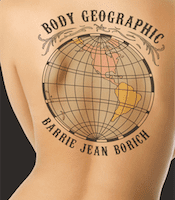In Body Geographic, Barrie Jean Borich charts the route by which she came to be located in middle age, in the Midwest, and in long-term love with Linnea, a spouse who occupies the middle space of gender. Through jazz, photography, travel, sex, and lineage—including several generations of coffee pots—Borich tells of her individual journey towards full, adult consciousness, towards certitude of self and place. But beyond the particulars of auto-cartography (the map dots, if one is to hew to this book’s central metaphor), Body Geographic asks the question, if “everything we love changes our location, and locations are always in some state of change,” then where, and consequently who, are we?
Borich’s lyric mapping begins in, and radiates out from, Chicago, her white city of origin, and arrives in blue Minneapolis. But neither city is a static terminus. Rather, Chicago is manifested as both alabaster city and “stinking toilet-scape”—it contains in it the immigrant neighborhoods where her forebears settled after leaving Old Bohemia, and the South Side Projects where Borich’s mother was raised, as well as the “rumble and muck” of the author’s own childhood haunts. Chicago is all of this and more, and Borich is Chicago. Then, not yet realizing that “we become what we come to know,” Borich sets out to become somewhere else.
“I really had little idea where, or how, to live. Perhaps my geography was killing me,” Borich writes of her younger, inebriated self on the cusp of going elsewhere. So she leaves home for new places, for terra incognita and those other-lands where there be monsters, real and imagined. She wanders dim-lit streets, drives the flooded parishes of New Orleans, tattoos her familiar skylines on her back, and realizes that “All cities are really double cities: the city itself and another city, the city of possibility, a projection of the real, the manifestation, part practical, part erotic, of what we wish for in our lives.”

To mesh together the coordinates of her self-location—love stories with personal and ancestral histories, the tales of her two cities with a series of “TripTiks”—Borich uses an extended metaphor of maps and mapmaking. Like the jazz Borich describes as having “a theme, repeating, adhered to…improvisation with an anchor,” the refrain of the mapping metaphor is, on occasion, relentless, as if the author never trusts the reader to arrive at the connection unprompted, to infer or intuit a pattern without its rigorous application. But predilection for downbeats aside, there is much pleasure to be had in this book’s form. Borich has composed Body Geographic to mimic the cartographic process, the text a two-dimensional albeit layered and evolving representation of the multitudinous self and the shifting landscapes we inhabit. The book is inserted with an array of maps and even has its own textual topography in that braided stories are sub-headed as “overlays” and “insets” (i.e., “Inset of Body Improvisation,” “Overlay of Open Space,” or “Panorama View, with Crossroads”). In its form, the book is a representation of a representation, but the effect isn’t so theoretical as it is constructed out of its parts—parts that look and feel a bit like this inset imitation:
Inset of Writing One’s Own Life
“The difference between the show and the truth is like the difference between the map and the terrain,” Borich writes, ostensibly about maps and mapping but inferring also, as a veteran teacher of writing, the dilemmas of crafting nonfiction. As with the writing down of lives, “Maps say more about where we think we’ve been than where we actually reside.” Maps are no more like the landscape they represent than text on a page can reconstruct the body or the life it has lived; they are not renderings of self so much as propositions.
In all, Body Geographic navigates fluidly between recovery narrative, travelogue, family legend (in both the literary and cartographic senses of the word), and coming-of-(middle)age story, and in so doing posits a new telling (or re-mapping) of the American story. “All Americans, even the most put-upon among us, might have a little bit of empire building in our makeup, some desire to refind the lost parts of ourselves through locating and owning, landing somewhere and inscribing our names,” Borich writes. By “somewhere,” she infers not merely latitude and longitude, but place and flesh and gender, self and other, past and present. She reveals how we lay claim to our physical and historical geography, to our lovers and to our own bodies—all of it real and imagined—and mark it ours, even as it makes us who we are.




